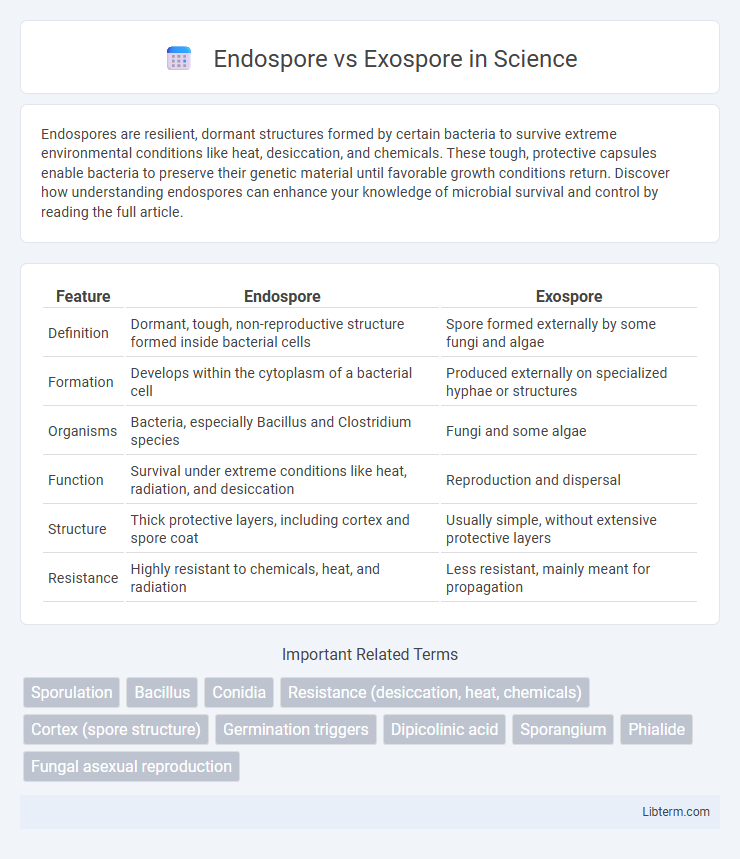Endospores are resilient, dormant structures formed by certain bacteria to survive extreme environmental conditions like heat, desiccation, and chemicals. These tough, protective capsules enable bacteria to preserve their genetic material until favorable growth conditions return. Discover how understanding endospores can enhance your knowledge of microbial survival and control by reading the full article.
Table of Comparison
| Feature | Endospore | Exospore |
|---|---|---|
| Definition | Dormant, tough, non-reproductive structure formed inside bacterial cells | Spore formed externally by some fungi and algae |
| Formation | Develops within the cytoplasm of a bacterial cell | Produced externally on specialized hyphae or structures |
| Organisms | Bacteria, especially Bacillus and Clostridium species | Fungi and some algae |
| Function | Survival under extreme conditions like heat, radiation, and desiccation | Reproduction and dispersal |
| Structure | Thick protective layers, including cortex and spore coat | Usually simple, without extensive protective layers |
| Resistance | Highly resistant to chemicals, heat, and radiation | Less resistant, mainly meant for propagation |
Introduction to Endospores and Exospores
Endospores are highly resistant, dormant structures formed within certain bacteria to survive extreme environmental conditions such as heat, desiccation, and chemicals. Exospores, in contrast, are a type of asexual spore produced externally by some fungi and bacteria, facilitating reproduction and dissemination rather than survival under stress. Both endospores and exospores play crucial roles in microbial life cycles, but endospores emphasize long-term survival while exospores focus on propagation.
Definition and Basic Characteristics
Endospores are highly resistant, dormant structures formed within certain bacterial cells, primarily Bacillus and Clostridium species, to survive harsh environmental conditions. Exospores, also known as conidia, are asexual spores produced externally by fungi and some bacteria for reproduction and dispersal, lacking the extreme resistance properties of endospores. Endospores exhibit thick protective layers and metabolic inactivity, whereas exospores are typically less durable and involved in colony expansion.
Formation Processes: Endospores vs Exospores
Endospores form through a complex sporulation process within certain bacteria, involving multiple stages of DNA replication, asymmetric cell division, and the development of a highly resistant spore coat. Exospores are produced externally by fungi and algae through mitotic cell division, resulting in spore release without the extensive intracellular remodeling seen in endospores. The endospore formation process equips bacteria for extreme survival conditions, whereas exospore formation primarily facilitates fungal and algal reproduction and dispersal.
Structural Differences
Endospores are highly resistant, dormant structures formed within certain bacteria like Bacillus and Clostridium species, characterized by a thick protective coat, cortex, and core containing DNA and ribosomes. Exospores, produced externally by filamentous fungi and some bacteria, lack the complex internal layers of endospores and primarily consist of a single protective wall for dispersal and reproduction. The key structural difference lies in endospores' multilayered defense system enabling extreme environmental resistance, while exospores have a simpler external morphology suited for spreading rather than prolonged survival.
Organisms Producing Endospores and Exospores
Endospores are predominantly produced by certain Gram-positive bacteria, notably genera Bacillus and Clostridium, which form these highly resistant structures to survive extreme environmental conditions. Exospores, on the other hand, are less common and typically found in some fungi and algae, serving as reproductive spores released into the environment. The production of endospores is a unique bacterial survival strategy, while exospore formation is mainly associated with reproduction in eukaryotic microorganisms.
Environmental Resistance and Survival
Endospores exhibit exceptional environmental resistance due to their thick protective coat, dehydration, and high levels of calcium dipicolinate, enabling survival under extreme heat, radiation, desiccation, and chemical exposure. Exospores, produced externally by some fungi and algae, offer moderate resistance primarily to desiccation and nutrient scarcity but lack the robust protective mechanisms found in endospores. The superior durability of endospores ensures long-term survival in hostile environments, making them key in bacterial persistence and transmission.
Biological Functions and Significance
Endospores serve as highly resistant survival structures allowing bacteria like Bacillus and Clostridium species to withstand extreme environmental conditions, such as heat, desiccation, and chemical exposure. Exospores function primarily in reproduction and dispersal, aiding fungi and some algae in spreading to new habitats where nutrient availability may be limited. The biological significance of endospores lies in ensuring long-term bacterial survival and genetic continuity, while exospores contribute to population expansion and ecosystem colonization.
Detection and Identification Methods
Endospore detection primarily relies on differential staining techniques such as the Schaeffer-Fulton method, which uses malachite green to penetrate the tough spore coat, distinguishing endospores from vegetative cells. Exospore identification often involves microscopic examination combined with specific growth media that stimulate spore release externally, facilitating visualization of the spore anatomy. Molecular methods like PCR targeting spore-specific genes enhance accuracy in differentiating endospores from exospores in complex samples.
Applications in Science and Industry
Endospores, produced by bacteria such as Bacillus and Clostridium species, are highly resistant structures utilized in sterilization testing and biological research due to their extreme durability and longevity. Exospores, formed by certain fungi and algae, are important in biotechnology and agriculture for their role in reproduction and environmental adaptability, aiding in crop improvement and biofertilizer development. Understanding the unique formation and resistance of endospores versus exospores guides applications in microbial control, pharmaceutical production, and sustainable agricultural practices.
Key Differences Summarized
Endospores are highly resistant, dormant structures formed within certain bacteria like Bacillus and Clostridium to survive extreme conditions, while exospores are externally produced spores seen in fungi and some plants for reproduction. Endospores have a thick protective coat containing dipicolinic acid, contributing to their durability against heat, radiation, and chemicals, whereas exospores typically lack such complex resistance features. Moreover, endospore formation is a survival mechanism triggered by nutrient limitation, whereas exospore formation is primarily involved in dispersal and lifecycle continuation.
Endospore Infographic

 libterm.com
libterm.com